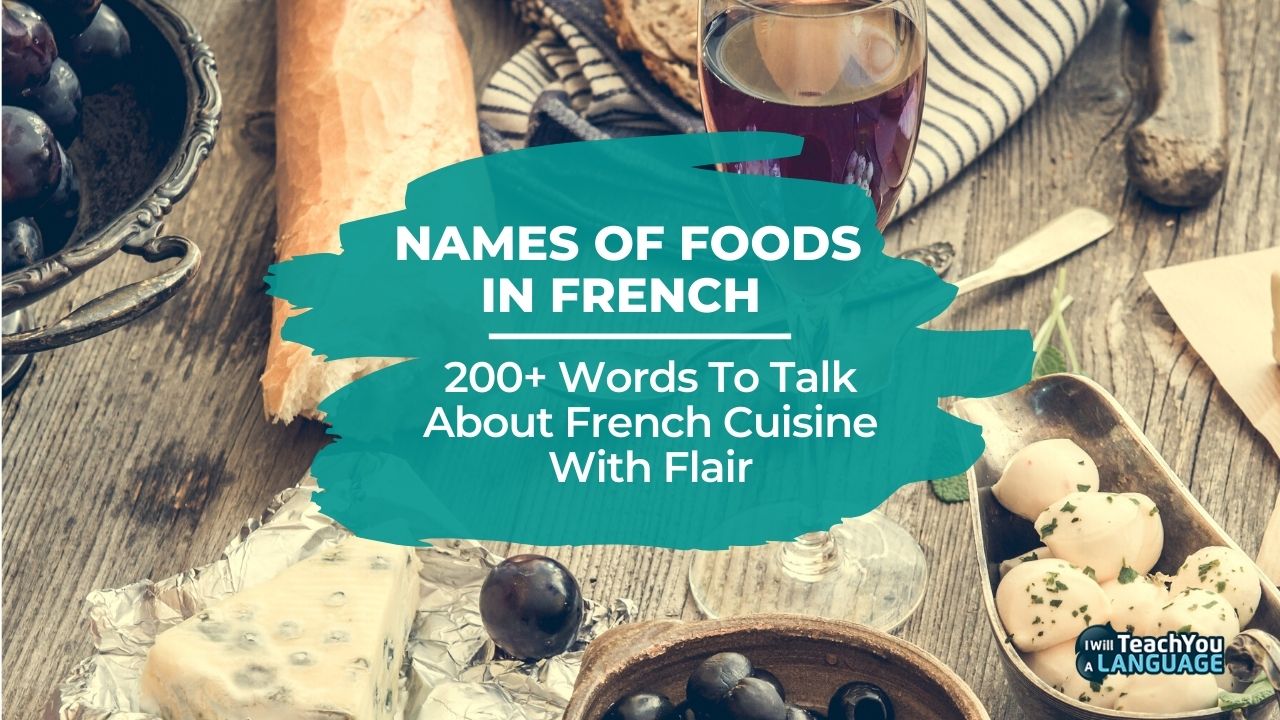
When you learn French and start to learn more about the culture, you can't avoid the topic of cuisine, so learning names of foods in French is a must!
In France, the preparation and appreciation of food has been elevated to the status of a fine art, and possibly nowhere else is the food of a country so inextricably linked with its culture, the identity of its people and their sense of national pride.
French cuisine is famous the world over, but if you want to understand French gastronomie, first, you need to know the basics.
So to help, here’s a list of names of foods in French – along with a few cultural tips that might come in handy while you’re visiting the country.
You'll be taking about food with flair in French in no time!
By the way, if you want to learn French fast and have fun while doing it, my top recommendation is French Uncovered which teaches you through StoryLearning®.
With French Uncovered you’ll use my unique StoryLearning® method to learn French naturally through story… not rules. It’s as fun as it is effective.
If you’re ready to get started, click here for a 7-day FREE trial.

Meat And Poultry In French
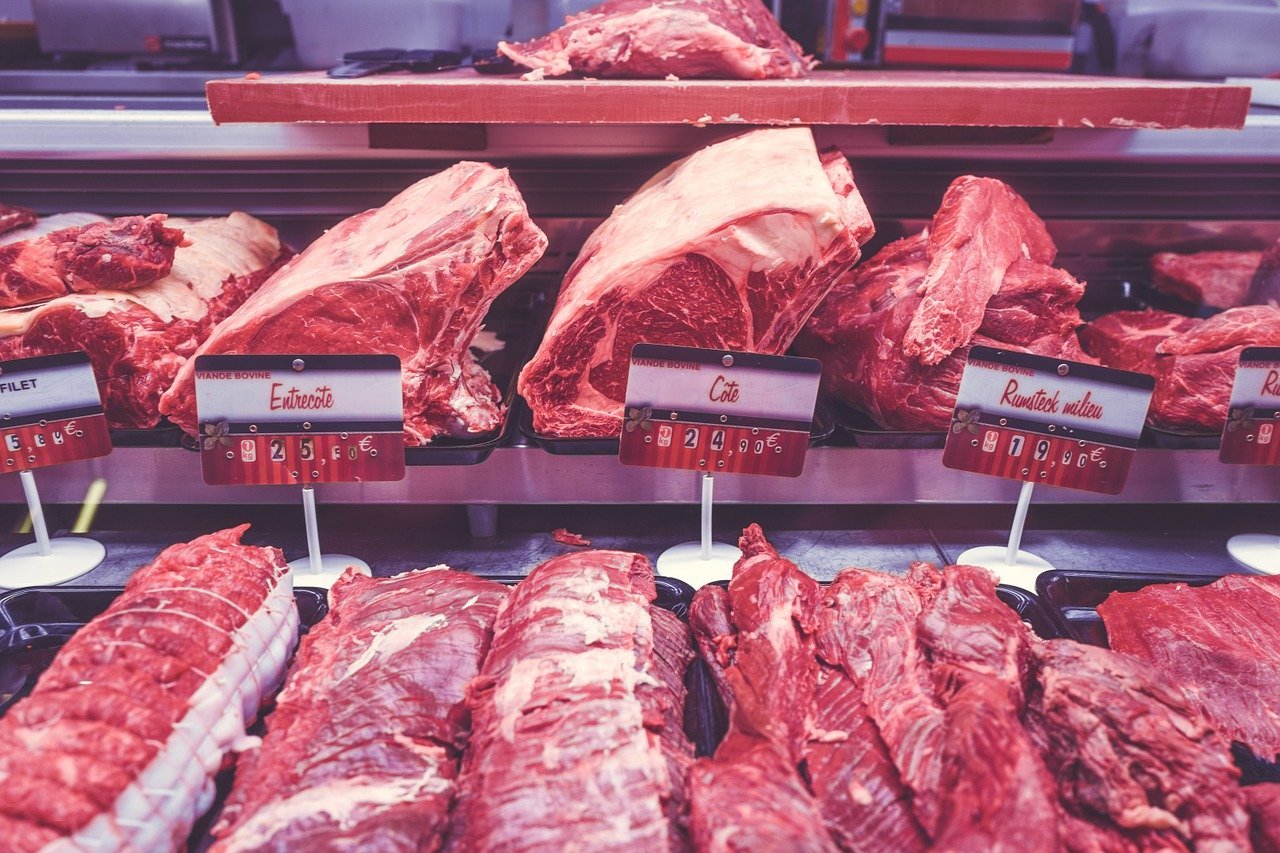
First things first, here are some essential words you'll need at the butcher's, market or restaurant if you want to buy or order meat in France.
- #1 viande (f) meat
- #2 viande hachée (f) minced meat
- #3 poulet (m) chicken
- #4 porc (m) pork
- #5 agneau (m) lamb
- #6 côte d’agneau (f) lamb chop
- #7 bœuf (m) beef
- #8 steak haché (m) burger (patty only, without the bun)
- #9 veau (m) veal
- #10 canard (m) duck
- #11 oie (f) goose
- #12 dinde (f) turkey
In French, a burger patty (the meat alone without the bun) is called a steak haché – and sometimes just a steak for short. This can be confusing for English speakers because in English, “steak” refers only to a thick slice of meat.
How To Talk About Steaks In French
Talking about steaks and how you like them cooked can get a little tricky in French as you'll see below. In the meantime, here are some key words to get your steak order right at the restaurant.
- #13 steak (m) steak
- #14 entrecôte (m) rib steak
- #15 filet (m) fillet
- #16 bleu blue
- #17 saignant rare
- #18 à point medium
- #19 bien cuit well done
Generally speaking, the French prefer their steaks a bit rarer than British or Americans. This means à point would be slightly less cooked than a British or American medium steak and bien cuit would be less cooked than a well-done steak in the UK or America.
If you want it cooked more, you can ask for très bien cuit – although you might find yourself on the end of some condescending looks!
A dish to watch out for in France is steak tartare. You might imagine this would be a regular steak served with tartar sauce – but you’d be very wrong. In fact, this dish is a serving of raw ground beef (or sometimes horse) accompanied by a range of seasonings and sometimes a raw egg on top.
Cold Meat
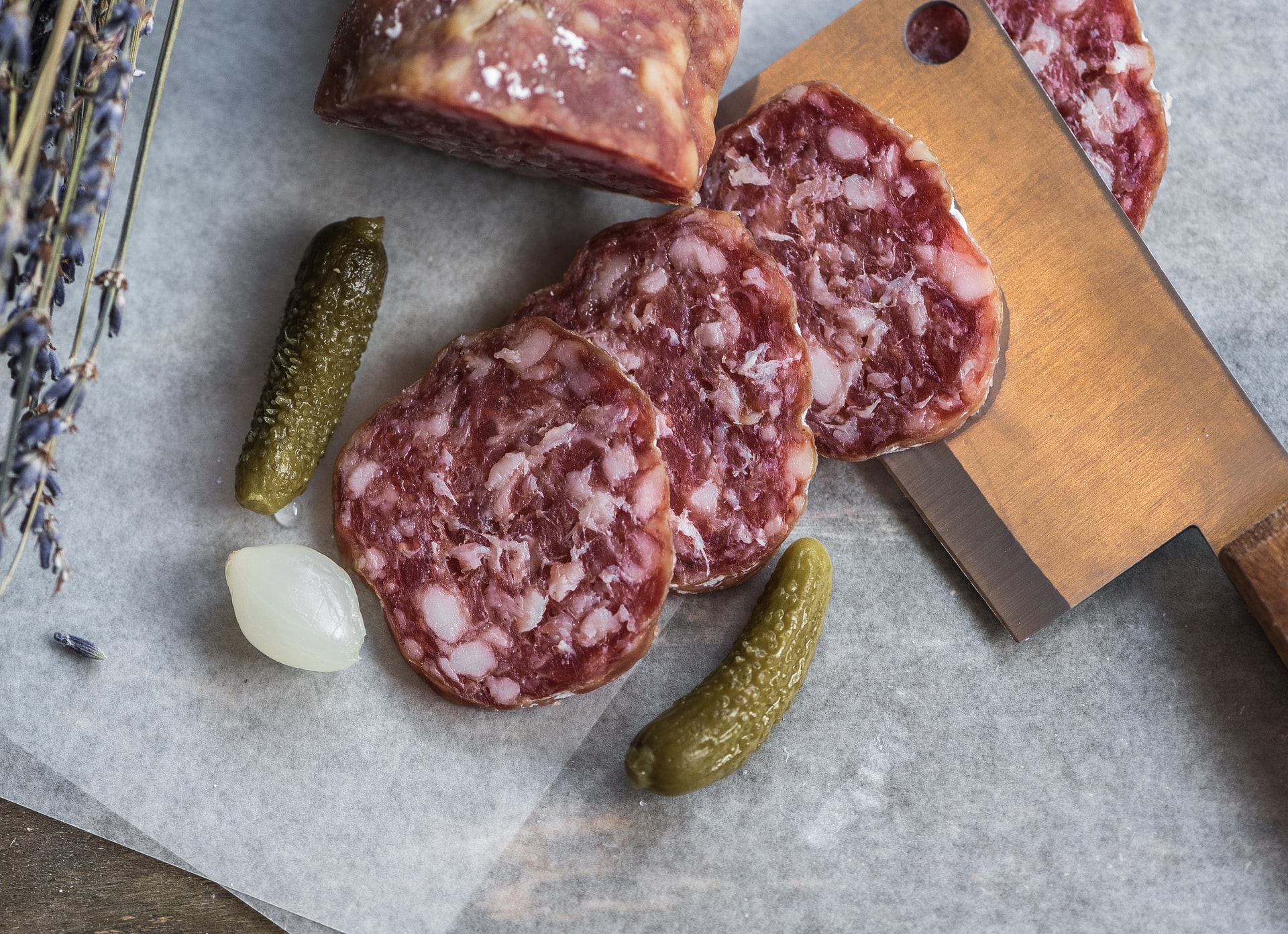
Let's not forget cold meat – here are a few key terms you'll need for ordering ham and other cold meat specialities in France.
- #20 charcuterie (f) cold meats, charcuterie
- #21 jambon (m) ham
- #22 jambon cru (m) cured ham
- #23 salami (m) salami
- #24 saucisson (m) saucisson
Fish And Seafood
Off to a seaside destination? Or just a fan of fish and seafood? The words below will help you talk about your favourite fish dishes.
- #25 poisson (m) fish
- #26 fruits de mer (mpl) seafood
- #27 thon (m) tuna
- #28 espadon (m) swordfish
- #29 lotte (f) monkfish
- #30 bar (m) sea bass
- #31 truite (f) trout
- #32 saumon (m) salmon
- #33 saumon fumé (m) smoked salmon
- #34 calamar (m) squid
- #35 seiche (f) cuttlefish
- #36 poulpe (m) octopus
- #37 homard (m) lobster
- #38 crabe (m) crab
- #39 crevette (f) prawn, shrimp
- #40 moule (f) mussel
- #41 noix de Saint-Jacques (m) scallop
- #42 huitre (f) oyster
Live oysters are considered a delicacy in France and are eaten with just a squeeze of fresh lemon juice. Mussels are a speciality anywhere with a coast and are traditionally eaten with frites.
Names Of Vegetables In French
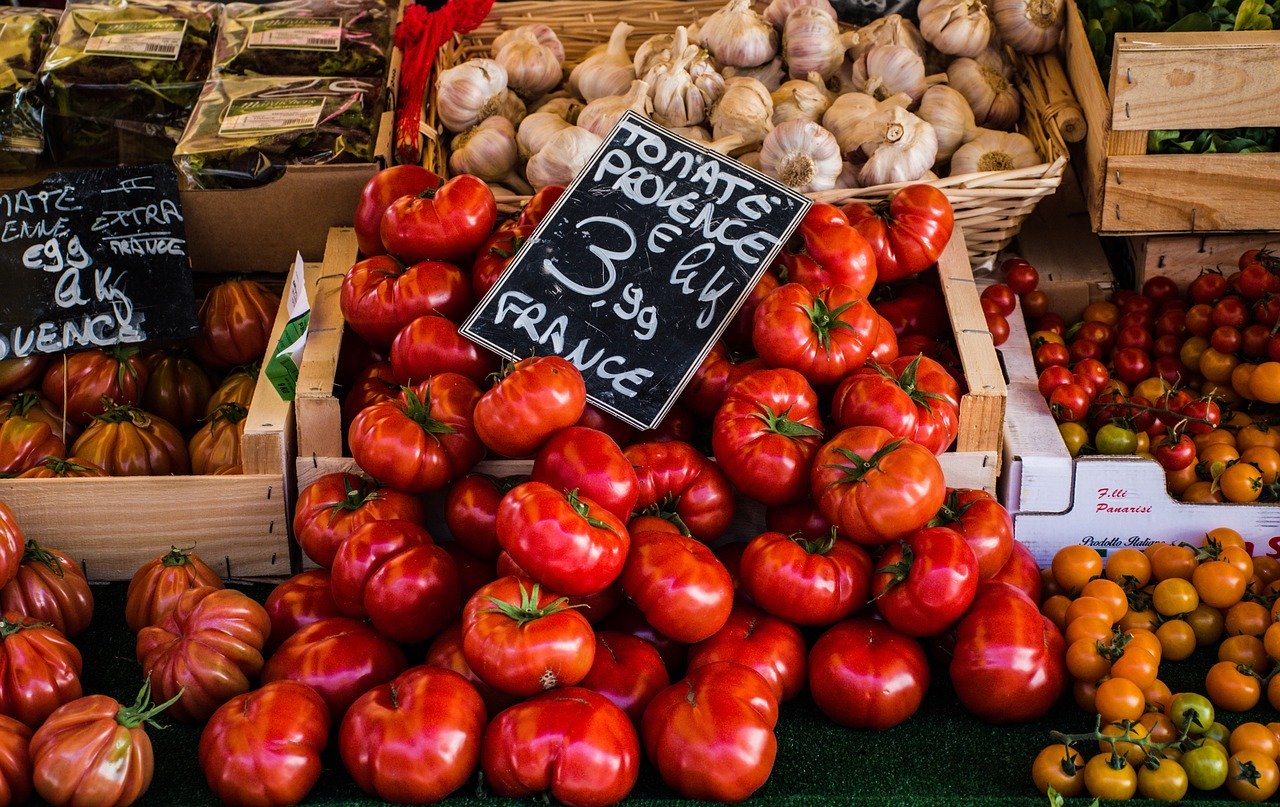
Next come the vegetable words you'll need when you're down at the market loading up on delicious fresh produce.
- #43 légume (m) vegetable
- #44 pomme de terre (f) potato
- #45 patate (f) potato
- #46 carotte (f) carrot
- #47 petit pois (m) pea
- #48 chou (m) cabbage
- #49 chou de Bruxelles (m) Brussels sprout
- #50 chou-fleur (m) cauliflower
- #51 brocoli (m) broccoli
- #52 artichaut (m) artichoke
- #53 poireau (m) leek
- #54 aubergine (f) aubergine, eggplant
- #55 courgette (f) courgette, zucchini
- #56 asperge (f) asparagus
- #57 haricot (m) bean
- #58 olive (f) olive
- #59 oignon (m) onion
- #60 ail (m) garlic
- #61 champignon (m) mushroom
Potatoes are called pommes de terre but are commonly referred to more informally as patates.
It is interesting to note that in British English, we use the French word “courgette” while Americans prefer the Italian word, “zucchini”.
It is also interesting that British English prefers “aubergine” while American English prefers “eggplant” – although, apparently, the word “eggplant” was coined by an Englishman who encountered a species that does indeed resemble a hen’s egg in Southeast Asia!

Herbs
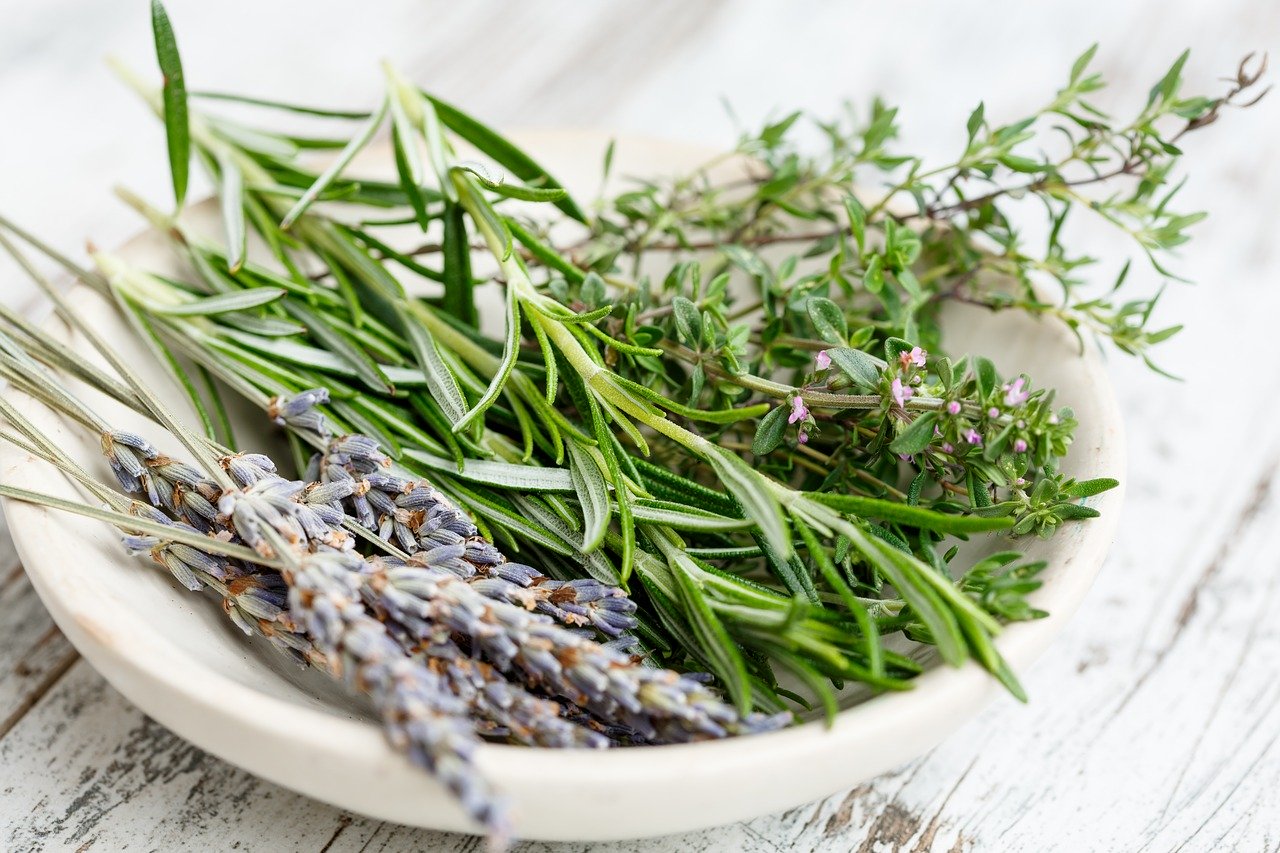
Herbs and spices are a key part of French cuisine so here's how to talk about the names of these foods in French.
- #62 herbe (f) herb
- #63 persil (m) parsley
- #64 coriandre (f) coriander, cilantro
- #65 menthe (f) mint
- #66 basilic (m) basil
- #67 romarin (m) rosemary
- #68 thym (m) thyme
- #69 origan (m) oregano
- #70 aneth (m) dill
Spices
- #71 épice (f) spice
- #72 cumin (m) cumin
- #73 muscade (f) nutmeg
- #74 paprika (m) paprika
- #75 cannelle (f) cinnamon
- #76 clou de girofle (m) clove
- #77 piment (m) chilli
In French people use the word épicé like the English word “spicy” to say something is “hot”, as in it contains lots of chilli. However, just like the English word, this is technically incorrect because it refers to spices and not chilli.
Instead, you can say pimenté (from piment), which means something has lots of chilli in it. When you put something that’s too spicy in your mouth, you can also say, “ça pique!” – “it’s hot!” (literally, “it pricks!”).
In general, the French don’t tend to eat as much “spicy” food as Brits or Americans.
Salad
- #78 salade (f) salade
- #79 salade (f) lettuce
- #80 tomate (f) tomato
- #81 tomate cerise (f) cherry tomato
- #82 maïs (m) sweetcorn
- #83 concombre (m) cucumber
- #84 betterave (f) beetroot
The word for “lettuce” is salade – which is also the same word used for a salad, as in the dish of cold vegetables. This means you might hear sentences like je vais acheter une salade pour faire de la salade (I’m going to buy a lettuce to make a salad). This might sound confusing, but usually it’s quite clear what you mean from the context!
Nuts
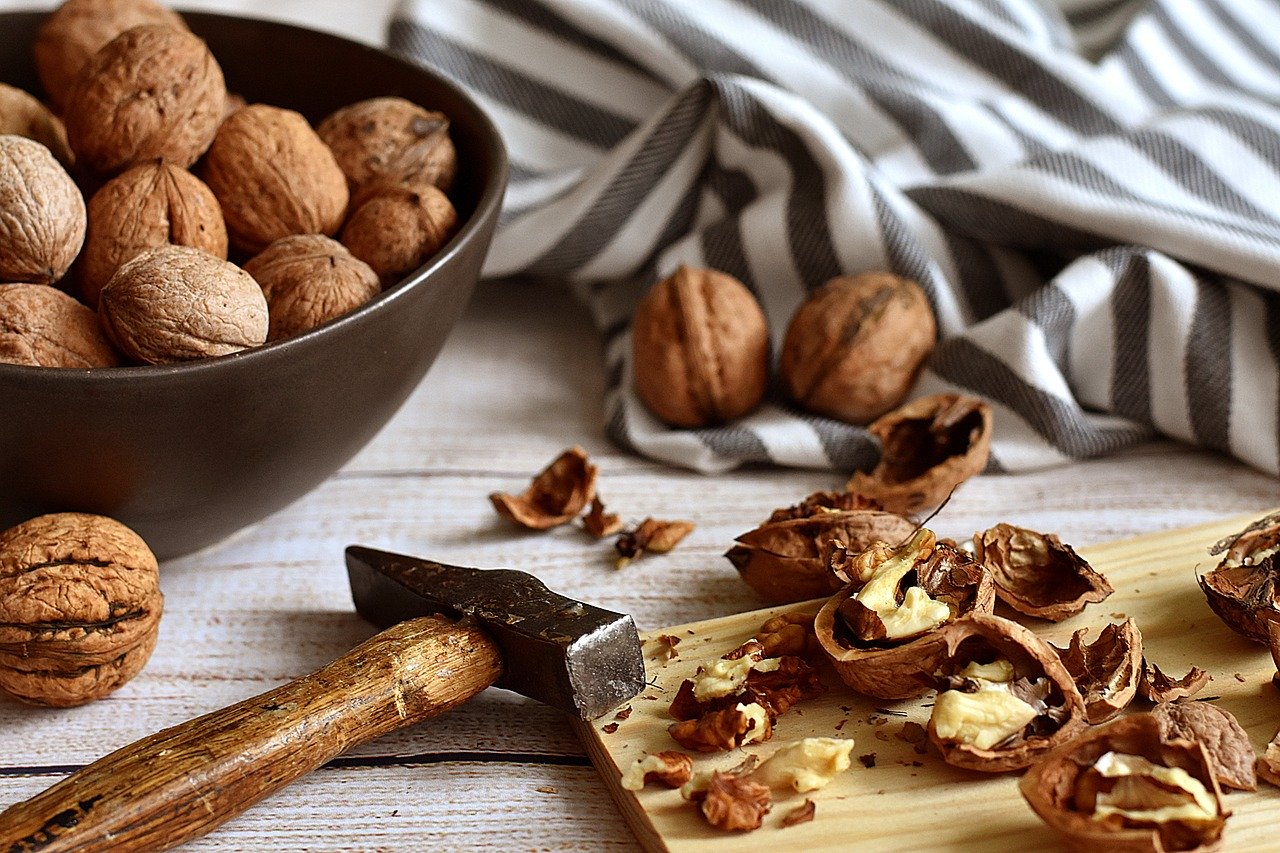
- #85 noix (f) nut
- #86 noix (f) walnut
- #87 cacahuète (f) peanut
- #88 pistache (f) pistachio
- #89 noix de cajou (f) cashew nut
- #90 amande (f) almond
- #91 noisette (f) hazelnut
- #92 noix de coco (m) coconut
There’s no real word for “nut” in French, and usually you would name the kind of nut you are talking about. The word noix means walnut, but it can be used to refer to nuts in general when you need to.
Fruit
In the mood for a healthy snack or have a delicious dessert you want to make? Here are the French fruit words you'll need from the everyday to the more exotic.
- #93 fruit (m) fruit
- #94 pomme (f) apple
- #95 orange (f) orange
- #96 poire (f) pear
- #97 cerise (f) cherry
- #98 abricot (m) apricot
- #99 nectarine (f) nectarine
- #100 pêche (f) peach
- #101 citron (m) lemon
- #102 citron vert (m) lime
- #103 ananas (m) pineapple
- #104 mangue (f) mango
- #105 papaye (f) papaya
- #106 melon (m) melon
- #107 pasthèque (f) watermelon
- #108 fraise (f) strawberry
- #109 framboise (f) raspberry
- #110 myrtille (f) blueberry
- #111 mûre (f) blackberry
- #112 cassis (m) blackcurrant
- #113 baie (f) berry
- #114 raisin (m) grape
- #115 raisin sec (m) raisin
The English word “raisin” comes from the French word for “grape”. A “raisin” in French is a raisin sec, literally a “dry grape”.
Desserts, Cakes And Treats In French
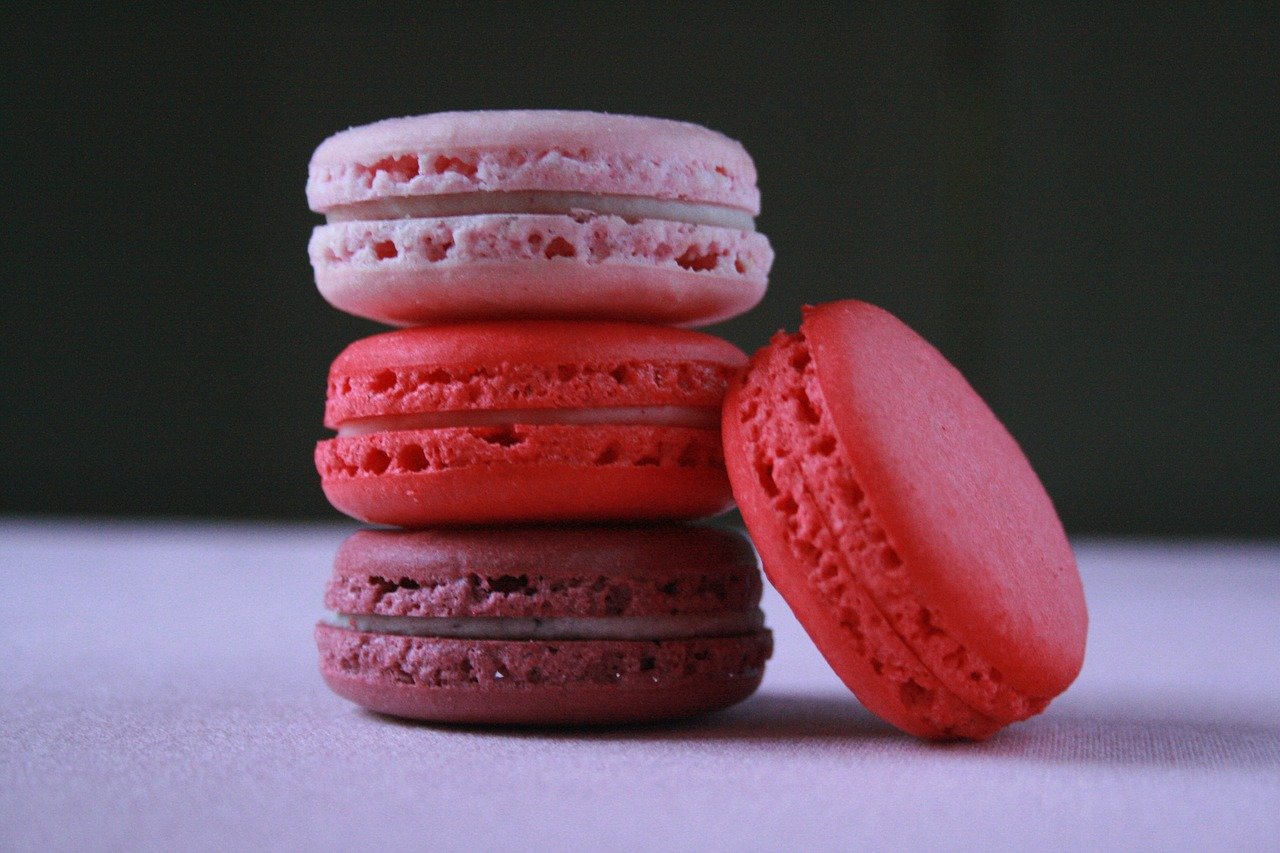
Any trip to France would be incomplete if it didn't involve a stop off at the bakery for at least one buttery croissant. Below you'll find some more pastry, cake and dessert words that will help you test out everything France has to offer in terms of sweet treats.
- #116 glace (f) ice cream
- #117 tarte (f) tart
- #118 gâteau (m) cake
- #119 croissant (m) croissant
- #120 pain au chocolat (m) pain au chocolat
- #121 pain au raisin (m) pain au raisin
- #122 meringue (f) meringue
- #123 mousse au chocolat (f) chocolate mousse
- #124 éclair (m) éclair
- #125 macaron (m) macaroon
- #126 profiterole (m) profiterole
- #127 tarte tatin (f) tarte tatin (a kind of tart with apples)
- #128 tarte citron meringuée (f) lemon meringue tart
- #129 chocolat (m) chocolate
- #130 bonbon (m) sweet, candy
- #131 caramel (m) caramel
In the bakery, French distinguishes between viennoiserie and pâtisserie. The former includes things like croissants and pains au chocolat that are eaten for breakfast while the latter is everything to do with cakes.
It is interesting that in the English-speaking world, we associate things like croissants with France – but the French language reminds us that they have their roots in Austria!
Also, note how many of the words in English are just the same as the French – so we know where we got them from!
Other Names Of French Foods
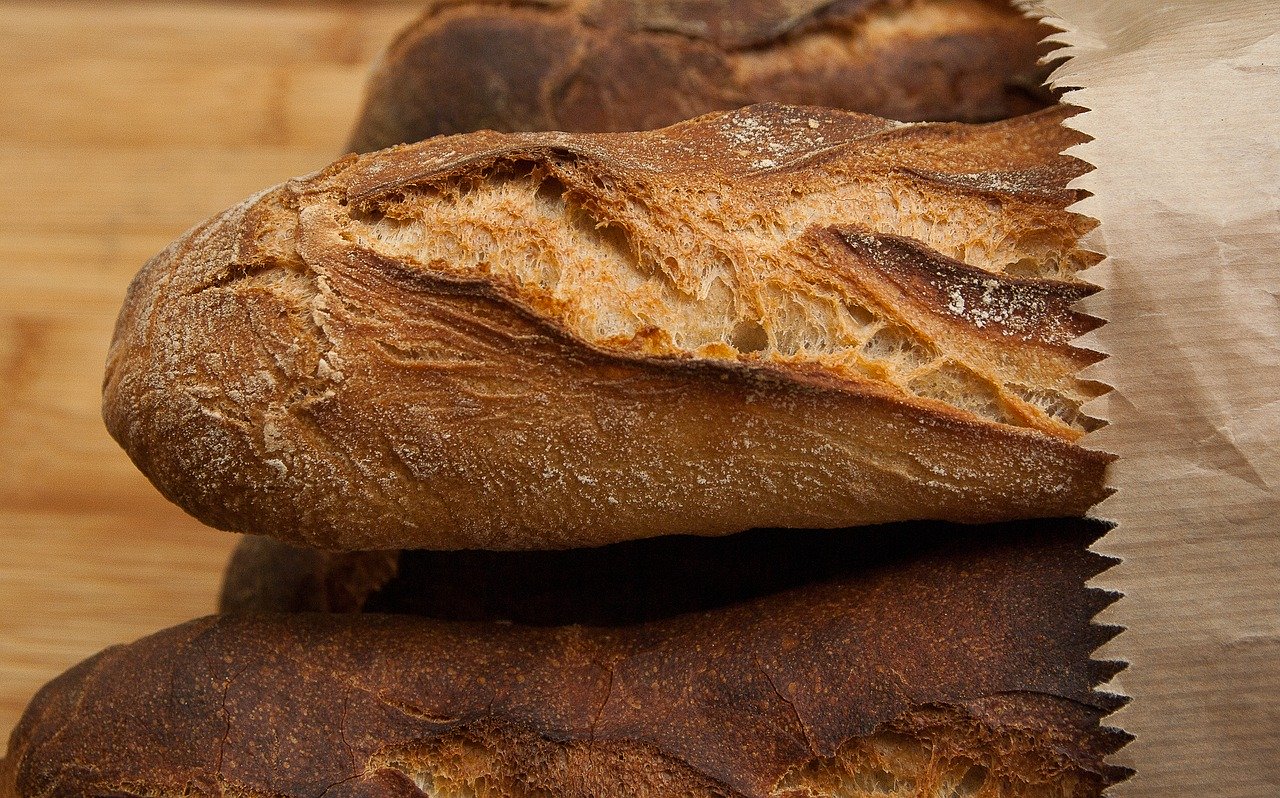
Below you'll find some names of French foods that fit best in an “other” category. This section includes some classics of French cuisine such as frog's legs or foie gras (more on this speciality in a second).
- #132 pain (m) bread
- #133 pâtes (fpl) pasta
- #134 nouilles (fpl) noodles
- #135 pizza (f) pizza
- #136 fromage (m) cheese
- #137 soupe (f) soup
- #138 œuf (m) egg
- #139 œuf dur (m) hard-boiled egg
- #140 œuf à la coque (m) soft-boiled egg
- #141 œuf sue le plat (m) fried egg
- #142 omelette (f) omelette
- #143 cuisses de grenouille (fpl) frog’s legs
- #144 escargot (m) snail
- #145 pâté (m) pâté
- #146 foie gras (m) foie gras
- #147 frites (fpl) chips (UK), fries (US)
- #148 chips (mpl) crisps (UK), chips (US)
- #149 beurre (m) butter
- #150 farine (f) flour
- #151 huile (f) oil
It’s true that the French eat frog’s legs, although it’s harder and harder to find them in restaurants nowadays.
Foie gras is an expensive delicacy and is an important – almost ritual – element of the Christmas meal for many households. It is served before the entrée with slices of a special type of soft warm bread, usually accompanied by a glass of white wine. Take a slice and place it on the bread, never spread it like pâté. And never refer to it as pâté in front of a French person!
French people use the words nouilles and pâtes interchangeably – in French, nouilles doesn’t necessarily mean the kind from the Far East. If you need to specify, you can say nouilles asiatiques (Asian noodles).

Names Of Condiments In French
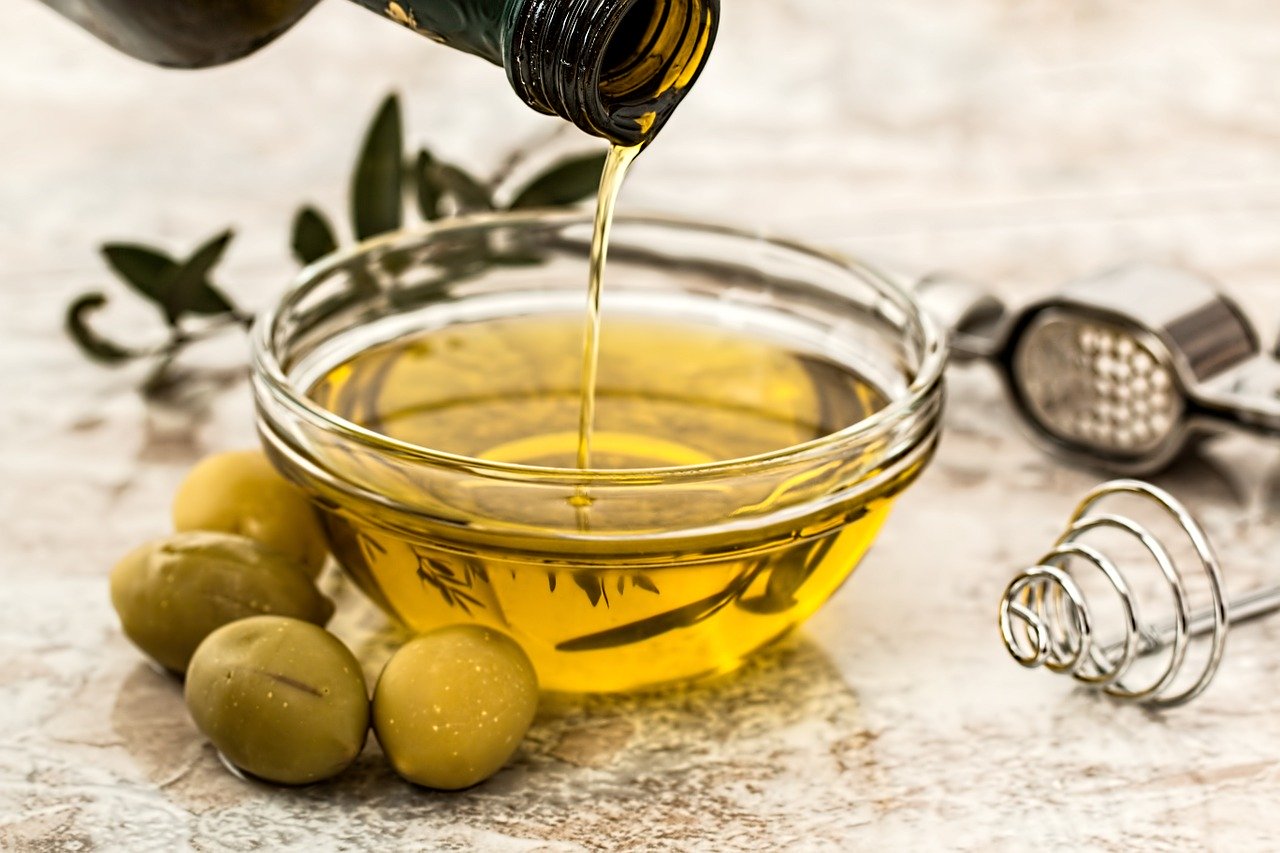
No meal is complete without seasoning, particularly a French one. So here are the words you'll need to add a bit more flavour to your dishes.
- #152 sel (m) salt
- #153 poivre (m) pepper
- #154 moutarde (f) mustard
- #155 sauce (f) sauce
- #156 sauce de soja (f) soy sauce
- #157 vinaigrette (f) vinaigrette, salad dressing
- #158 mayonnaise (f) mayonnaise
- #159 vinaigre (f) vinegar
- #160 huile d’olive (f) olive oil
- #161 sucre (m) sugar
The French word for vinegar, from which the English word is derived, comes from vin aigre – which literally means “sour wine”.
French Drinks
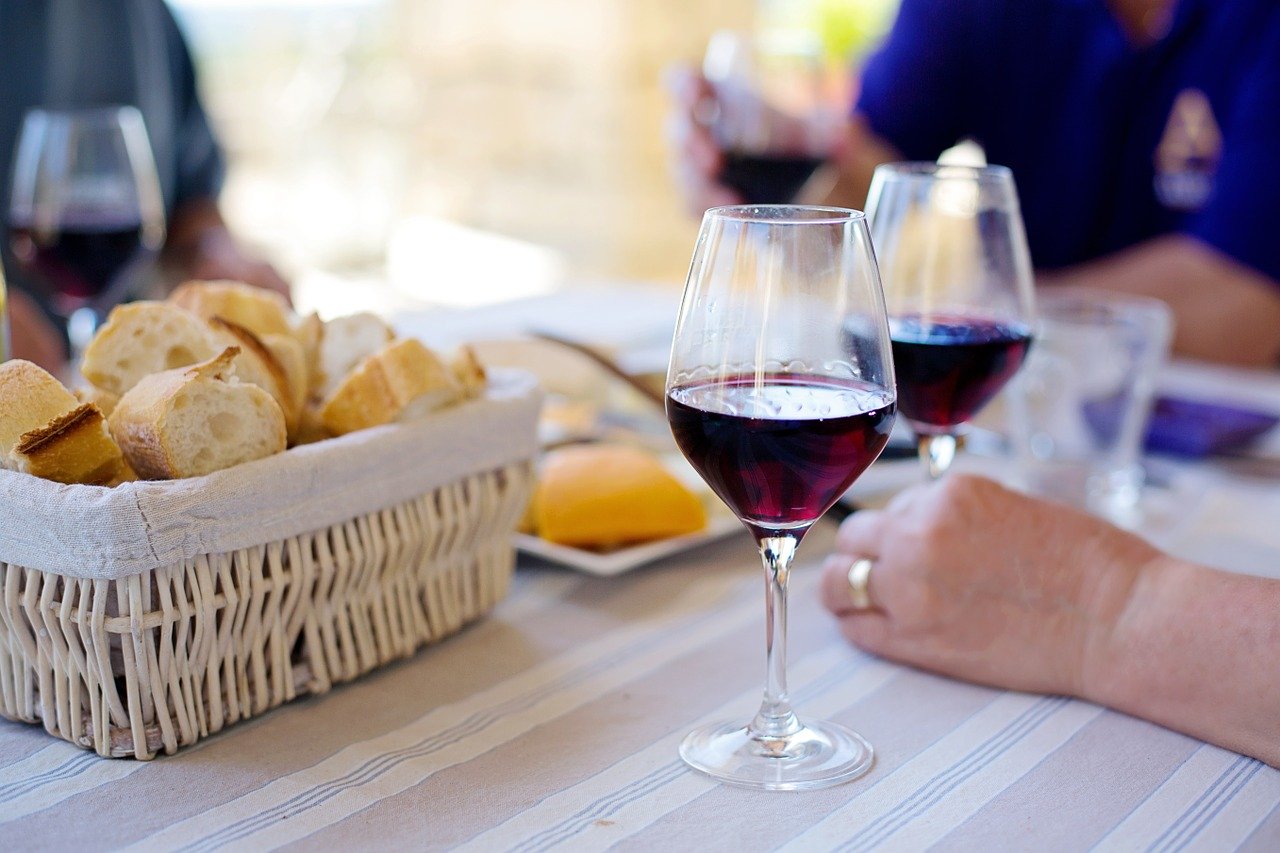
After eating all that French food, you”ll need something to wash it down with so here are the names of some drinks in French that could be useful to you when eating out or dining at a French friend's house.
- #162 eau (f) water
- #163 eau plate (f) still water
- #164 eau gazeuse, eau pétillante (f) sparkling water
- #165 eau minérale (f) mineral water
- #166 café (m) coffee
- #167 café au lait (m) coffee with milk
- #168 café noir (m) black coffee
- #169 expresso (m) espresso
- #170 thé (m) tea
- #171 tisane (f) infusion, herbal tea, tisane
- #172 chocolat chaud (m) hot chocolate
By the way, if you ask for a café when at a French bar or restaurant, you'll be served a small, espresso coffee as standard. This may come as a surprise if you're expecting a big American-style mug of the stuff.
If you want a longer coffee, then you can order a café allongé which is essentially an Americano.
Alcohol
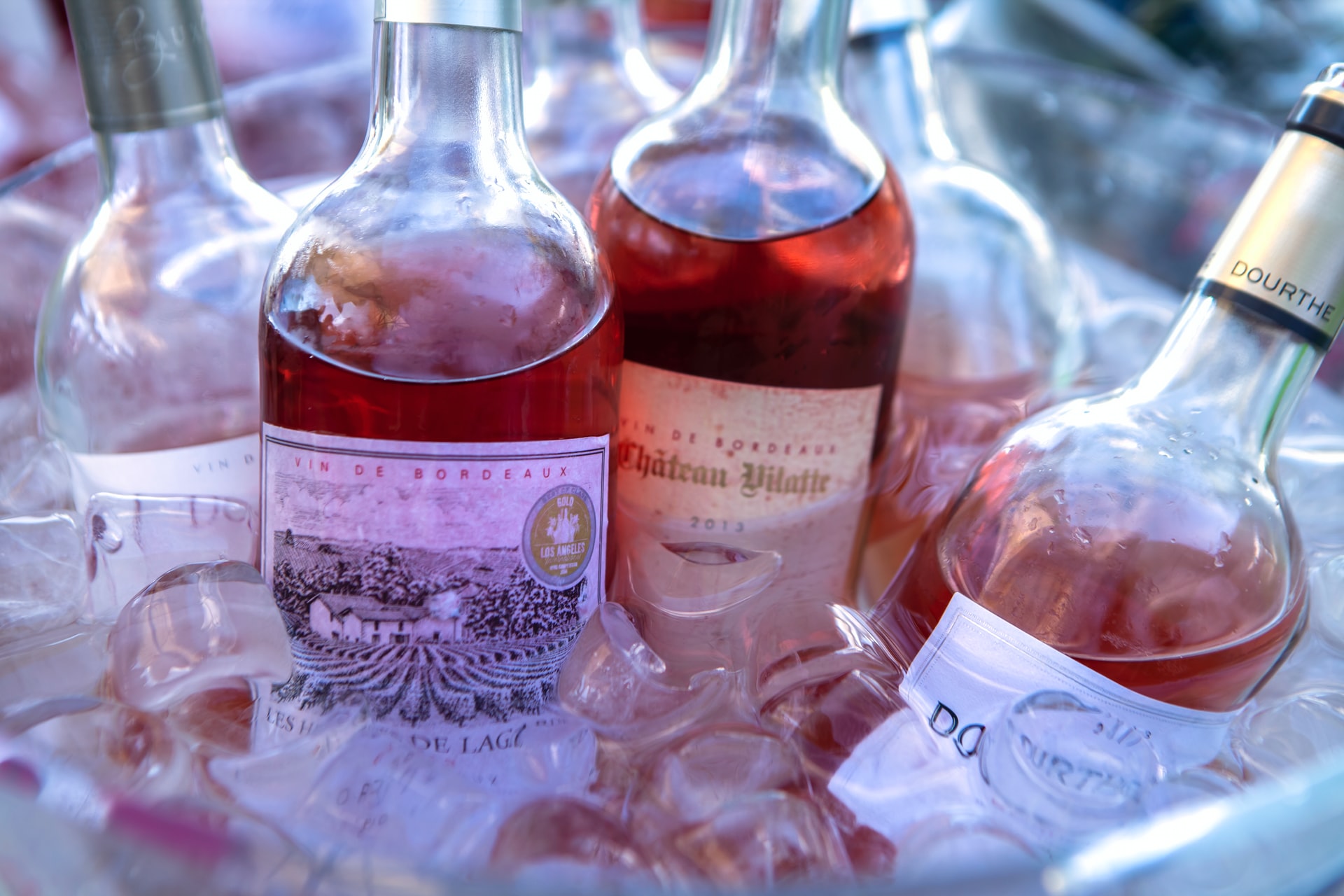
- #173 alcool (m) alcohol
- #174 boisson alcoolisée (f) alcoholic drink
- #175 apéritif (m) aperitif
- #176 digestif (m) digestive
- #177 bière (f) beer
- #178 vin (m) wine
- #179 vin rouge (m) red wine
- #180 vin blanc (m) white wine
- #181 vin rosé (m) rosé
- #182 vin chaud (m) mulled wine
- #183 champagne (m) champagne
- #184 whisky (m) whisky
- #185 rhum (m) rum
- #186 vodka (f) vodka
- #187 tequila (f) tequila
- #188 pastis (m) pastis
- #189 cocktail (m) cocktail
Before a meal, you may be served an apéritif, an alcoholic drink that comes before the meal to awaken your hunger. A traditional French apéritif is pastis, a clear aniseed-flavoured spirit.
You drink it with an ice cube and some water – and when you mix in the water, it becomes cloudy. Pastis is especially popular in the south around Marseille. Two of the most famous brands are Ricard and Pernod.
You should not take a sip of your apéritif until everybody has been served and before everyone has touched glasses. When you touch glasses, it is important to look each person in the eye, and you should avoid crossing arms with people as you all touch glasses. When you touch glasses, you can say santé – or more informally, tchin.
The French word for touching glasses is trinquer. Prendre l’apéro is the custom of having a drink and nibbles with friends before a meal.
At the end of the meal, you may also be served a digestif to help everything go down. This will usually be something like a cognac or an armagnac – or in Normandy, perhaps a calvados, a fiery spirit made from apples.
At The Table In France
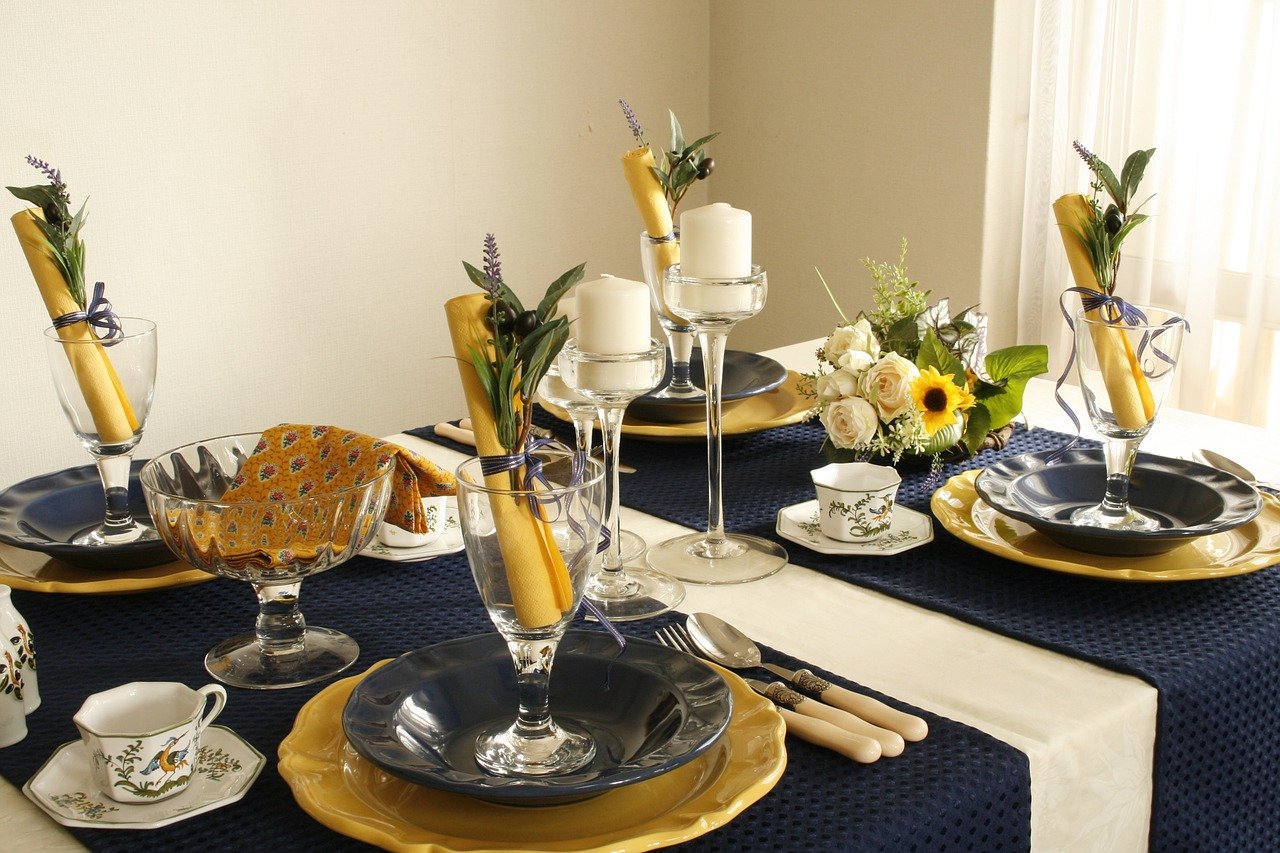
If you're dining at a French friend's house and you want to be a good guest and help out with setting the table, here are some useful words for talking about that.
- #190 table (f) table
- #191 couteau (m) knife
- #192 fourchette (f) fork
- #193 cuillère (f) spoon
- #194 cuillère à café (f) teaspoon
- #195 cuillère à soupe (f) tablespoon
- #196 verre (m) glass
- #197 tasse (f) cup
- #198 mug (m) mug
- #199 serviette (f) serviette, napkin
- #200 nappe (f) tablecloth
- #201 mettre la table lay the table
When each course arrives, you should wait until everybody is served before starting to eat. It is considered very rude to begin eating before everyone is served – unless the host tells you to start before it gets cold.
When the first course has arrived and everyone has been served, it is customary to say bon appétit! before everyone starts eating.
You'll find more useful French expressions for situations like meals and much more in this post.
Cooking Methods
Are you a keen cook? You might be interested in these words that will help you describe which cooking methods you like to use. These will also help you understand descriptions on French menus.
- #202 sauté shallow-fried, sautéed
- #203 rôti roasted
- #204 frit fried
- #205 bouilli boiled
- #206 poché poached
- #207 à la vapeur steamed
A French Meal
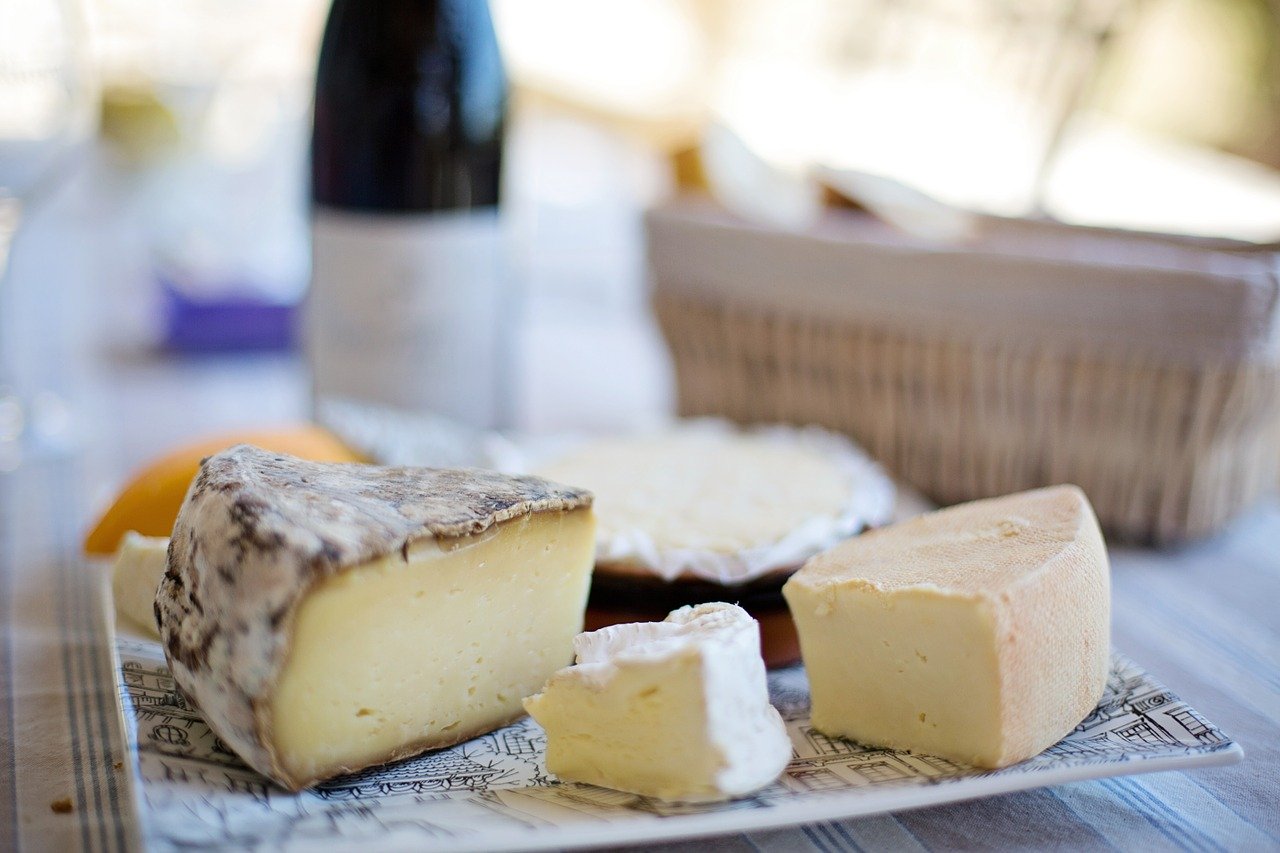
- #208 entrée (f) entrée, starter, first course
- #209 plat (m) main course
- #210 dessert (m) dessert
After the apéritif, a traditional French meal starts with an entrée, something light and often cold. This is then followed by the plat, (the main course). The meal is usually accompanied by bread, which you can place on the table next to your plate.
After the plat comes the fromage, (the cheese). In France, cheese is not considered a dessert – it is eaten between the main course and the dessert – and is eaten with bread rather biscuits, unlike in the UK. There will usually be at least a few different types to try.
There is a standard joke during the cheese course that when you finish your bread, you have to take another piece to ‘finish your wine and your cheese’. And then you need another piece of cheese ‘to finish your wine and bread’. Then you need another glass of wine ‘to finish your bread and cheese’. And so on. It’s always a good excuse to keep eating and drinking!
Finally, when you’ve had your fill of cheese (and bread and wine), you will be served your dessert. This is followed by coffee – and sometimes a digestif.
Regional French Dishes
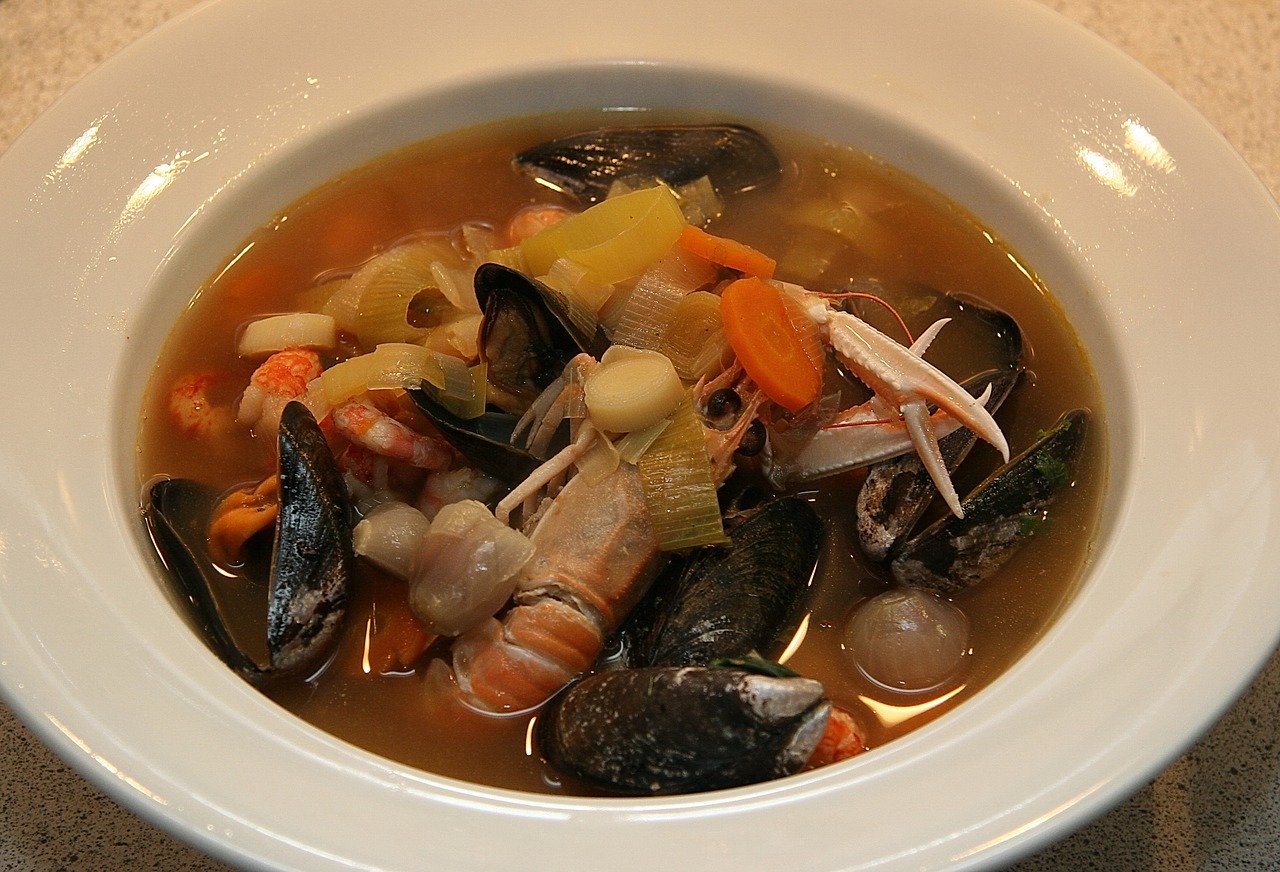
Just as French regional accents can vary, there are also so many regional dishes from every corner of the country. These are but a few of the classics.
- #211 boudin blanc aux pommes white pudding with apples (Normandy)
- #212 Flammenküche flat bread base with lardons, cream, onions (Alsace)
- #213 tartiflette potatoes, cheese, lardons, onions (Savoy region)
- #214 bouillabaisse fish stew (Marseille)
- #215 raclette raclette cheese with potatoes and charcuterie (Alps)
- #216 ratatouille stewed vegetables (Provence)
- #217 cassoulet cassoulet (Languedoc)
You could write a whole book about the food of France – and of course, many people already have – but if you travel to France, your trip will undoubtedly be a journey of gastronomic adventure and discovery.
Names Of Foods In French: Bon Appétit!
Tasting local food and sampling local delicacies is an essential part of travel wherever you go, but during a trip to France, you will have the chance to enjoy one of the world’s great cuisines.
You might not be able to try everything there is on offer, but at least with this list of names of foods in French, you’ll have some idea of where to begin.
Hopefully this post has given you even more motivation to learn French. Learning the language can be a life-changing experience and you don't need to be a seasoned language learner to learn French fast.
So get started on your French learning journey so that you can taste some of the delicious food you've discovered in this post!


Olly Richards
Creator of the StoryLearning® Method
Olly Richards is a renowned polyglot and language learning expert with over 15 years of experience teaching millions through his innovative StoryLearning® method. He is the creator of StoryLearning, one of the world's largest language learning blogs with 500,000+ monthly readers.
Olly has authored 30+ language learning books and courses, including the bestselling "Short Stories" series published by Teach Yourself.
When not developing new teaching methods, Richards practices what he preaches—he speaks 8 languages fluently and continues learning new ones through his own methodology.









































